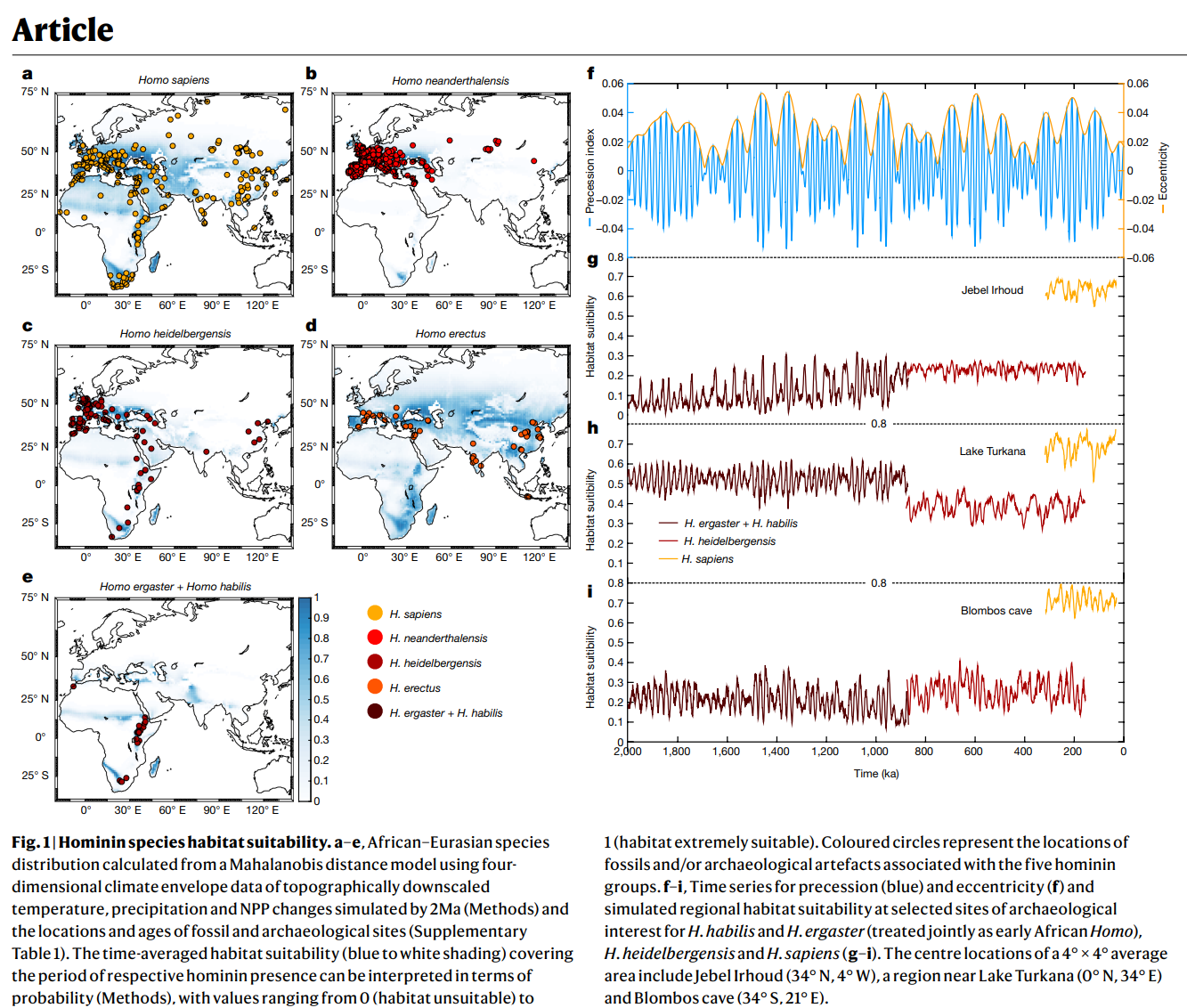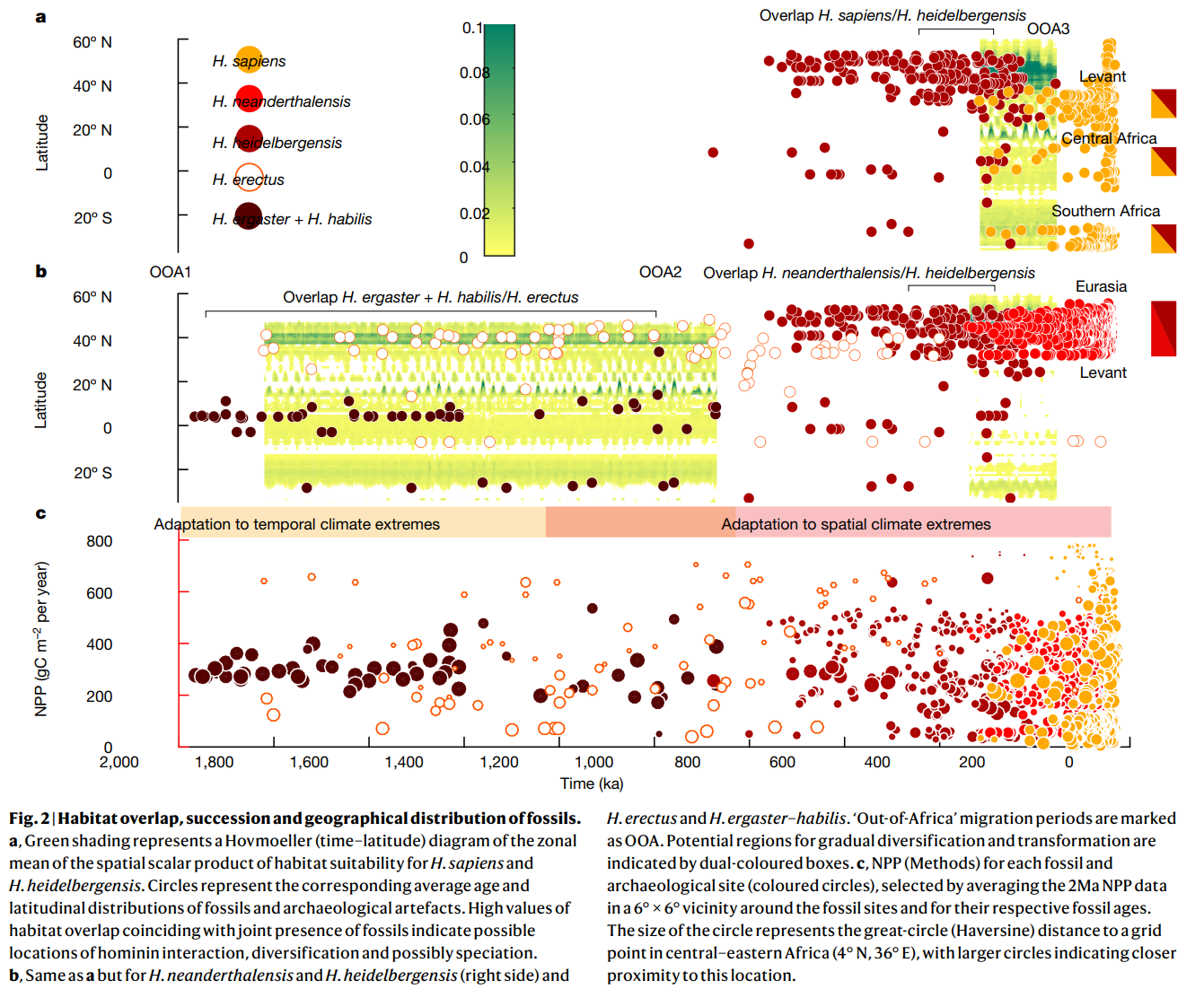文章信息:Axel Timmermann, Kyung-Sook Yun, Pasquale Raia, et al. (2022). Climateeffects on archaic human habitats and species successions. Nature, 604(7906): 495-501. https://doi.org/10.1038/s41586-022-04600-9.
整理人:杨文,2023级硕士生
整理时间:2024年4月18日
Abstract:It has long been believed that climate shifts during the last 2 million years had a pivotal role in the evolution of our genusHomo. However, given the limited number of representative palaeo-climate datasets from regions of anthropological interest, it has remained challenging to quantify this linkage. Here, we use an unprecedented transient Pleistocene coupled general circulation model simulation in combination with an extensive compilation of fossil and archaeological records to study the spatiotemporal habitat suitability for five hominin species over the past 2 million years. We show that astronomically forced changes in temperature, rainfall and terrestrial net primary production had a major impact on the observed distributions of these species. During the Early Pleistocene, hominins settled primarily in environments with weak orbital-scale climate variability. This behaviour changed substantially after the mid-Pleistocene transition, when archaic humans became global wanderers who adapted to a wide range of spatial climatic gradients. Analysis of the simulated hominin habitat overlap from approximately 300–400 thousand years ago further suggests that antiphased climate disruptions in southern Africa and Eurasia contributed to the evolutionary transformation of Homo heidelbergensis populations into Homo sapiens and Neanderthals, respectively. Our robust numerical simulations of climate-induced habitat changes provide a framework to test hypotheses on our human origin.
摘要:长期以来,人们一直认为过去200万年的气候变化在我们人属的进化中起着关键作用。然而,鉴于人类学感兴趣地区的代表性古气候数据集数量有限,量化这种联系仍然具有挑战性。在这里,我们使用了前所未有的瞬态更新世耦合环流模型模拟,结合化石和考古记录的广泛汇编,研究了过去200万年中五种人类物种的时空栖息地适宜性。我们表明,天文强迫的温度、降雨量和陆地净初级生产力的变化对这些物种的观测分布产生了重大影响。早更新世时期,人类主要定居在轨道尺度气候变化较弱的环境中。这种行为在更新世中期转变后发生了重大变化,当时古代人类成为全球流浪者,适应了广泛的空间气候梯度。对大约30万至40万年前模拟的人类栖息地重叠的分析进一步表明,南部非洲和欧亚大陆的反相位气候破坏分别促成了海德堡人种群向智人和尼安德特人的进化转变。我们对气候引起的栖息地变化进行了强有力的数值模拟,为检验人类起源的假设提供了一个框架。

图 人类物种生境适宜性
非洲-欧亚大陆的物种分布,由Mahalanobis距离模型计算得出,使用四维气候包络数据,即2Ma(方法)模拟的地形降尺度温度、降水和NPP变化(植物净初级生产力)以及化石和考古遗址的位置和年代(补充表1)。覆盖各自人类存在时期的时间平均栖息地适宜性(蓝色到白色阴影)可以用概率(方法)来解释,其值从0(栖息地不适宜)到1(栖息地极其适宜)。彩色的圆圈代表化石的位置和/或与五个人类群体有关的考古文物。f-i, 前移(蓝色)和偏心(f)的时间序列,以及在选定的具有考古意义的地点模拟的哈比利斯人和埃加斯特人(被共同视为非洲早期智人)、海德堡人和智人的区域生境适宜性(g-i)。一个4°×4°的平均区域的中心位置包括杰贝尔依罗人(北纬34度,西经4度),图尔卡纳湖附近的一个区域(北纬0度,东经34度) 和布隆伯斯洞窟(南纬34°,东经21°)。

图 化石的生境重叠、演替和地理分布
a,绿色阴影代表了智人和海德堡人生境适宜性的空间标量乘积的霍夫默勒图(气象学中用于描述波运动的一种常见绘图方法)(时间纬度)图。圆圈代表相应的平均年代,以及化石和考古文物的纬度分布。栖息地重叠的高值与化石的共同存在表明可能存在人与人之间的相互作用、多样化和可能的物种形成的地点。
b,与a的意义相同,但研究的为尼安德特人和海德堡人(右侧)和直立人和能人-匠人。“非洲以外”的迁移期被标记为OOA。逐渐多样化和转变的潜在区域由双色框表示。
c, 通过对2Ma NPP数据的平均选择使用NPP(方法),在化石地点周围6°×6°的范围内,根据各自的化石年代,探究每个化石和考古地点(彩色圆圈)。圆圈的大小代表了与非洲中东部(北纬4度,东经36度)一个网格点的大圆圈(Haversine)距离,更大的圆圈表示更接近这个位置。
原文链接:https://www.nature.com/articles/s41586-022-04600-9
节选转引:https://mp.weixin.qq.com/s/_7SQ_Z38SKhu3P805-kouA